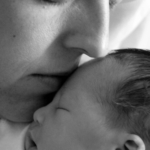PMDD affects 3-8% of women in their reproductive years, with symptoms usually emerging during a woman’s twenties. Clinically it has been observed that these symptoms may worsen over time; for example, it has been observed that some women may experience worsening of premenstrual symptoms after pregnancy or as they enter into menopause. It has furthermore been suggested that women with PMDD are more vulnerable to other types of reproductive transition-associated affective disorders, such as postpartum depression. However, the research addressing this association has been limited and variable in quality. A recent review from Pereira and colleagues provides important information on the link between PMDD and postpartum depression (PPD).
Hormonal Shifts and PMDD
During a normal menstrual cycle, pulsatile secretion of gonadotropin release hormone (GnRH) by the hypothalamus stimulates the secretion of follicle-stimulating hormone (FSH) and luteinizing hormone (LH) by the anterior pituitary gland. This is the first phase of the menstrual cycle, the follicular phase, during which follicles in the ovary mature and secrete estrogen. This phase lasts about 14 days, until LH levels peak, which induces ovulation. In the second phase of the cycle, the luteal phase, progesterone (produced by the corpus luteum) predominates. If ovulation does not occur, estrogen levels fall, and menstruation occurs.
The most widely accepted etiological theory of PMDD is that the symptoms of PMDD constitute an abnormal response to normal hormonal fluctuations during the menstrual cycle, particularly levels of estrogen and progesterone. Fluctuations in these steroid hormones modulate serotonergic, adrenergic, and GABA-ergic neurotransmission, the production of brain-derived neurotrophic factor (BDNF), the hypothalamic–pituitary–adrenal (HPA) axis and immune function.
Because similar hormonal shifts – specifically a dramatic fall in estrogen and progesterone levels — occur after childbirth during the postpartum period, many have asserted that women with PMDD are more vulnerable to postpartum depression than women without PMDD.
Methodologic Issues
PMDD has very specific diagnostic criteria and, according to the Diagnostic and Statistical Manual of Mental Disorders or DSM – V, symptoms “should be confirmed by prospective daily ratings during at least 2 symptomatic cycles”. There are many standardized assessments used to confirm the diagnosis of PMDD, such as the Daily Record of Severity of Problems (DRSP) and the Calendar of Premenstrual Experiences. The studies assessing the link between PMDD and PPD have used a variety of instruments to document PMDD symptoms, which may complicate interpretation of the data.
In addition, many of these studies have relied on retrospective charting to document PMDD. Previous studies have demonstrated that retrospective documentation of PMDD is not particularly accurate. More specifically, prospective charing is essential in distinguishing between PMDD and premenstrual exacerbation of an underlying mood or anxiety disorder, where residual symptoms are present during the follicular phase of the cycle and worsen prior to the onset of menses.
Systematic Review
Pereira and colleagues conducted a systematic review in accordance with the Preferred Reporting Items for Systematic Review and Meta-Analysis (PRISMA) guidelines. Searches were performed in PsycINFO, PubMed, EMBASE, Web of Science and CINAH databases. The authors included articles according to the following inclusion criteria: (1) retrospective or original prospective observational studies, published between 1999 and 2020, in English, Spanish, and Portuguese; (2) clear and operable definitions of PMDD and PPD; (3) use of validated instruments to assess PMDD and PPD; (4) analysis of the relationship between PMDD and PND.
The final review focused on seven articles. The participants included in the studies were between the ages of 18 and 44; the majority were married and living with their partner. Most of the studies (n=6) were retrospective. Most of the studies interviewed women during the postpartum period, asking them to recall their experiences of premenstrual symptoms prior to pregnancy. Two of the studies interviewed women with documented PMDD, asking women who had delivered a child about their experiences with postpartum depression.
The Findings
Six of the seven studies included in this systematic review observed a positive and significant association between PMDD and PPD. For example, the study from Vega-Dienstmaier et al. (1999) conducted a study including 425 women interviewed during the postpartum period. Women who reported a history of PMDD (versus those who did not report PMDD) were about three times as likely to have PPD during the first year after childbirth (OR?=?3.211, 95% CI 1.75–5.9, p?=?0.007). The other four studies using a similar design — retrospectively assessing the prevalence of premenstrual mood symptoms — demonstrated a link between PPD and PMDD.
Only two of the studies established the diagnosis of PMDD with prospective charting (Critchlow et al 2001, Kepple et al 2016). In a clinical sample of 34 women with confirmed PMDD and a control group of 22 women with no premenstrual mood changes, Critchlow and colleagues (2001) observed that nearly two-thirds of the women with PMDD had experienced a postpartum depressive episode compared to none of the women without premenstrual mood changes.
A single study (Kepple et al, 2016) did not observe an association between PMDD and PPD. This retrospective study assessed a clinical sample of 215 women with PMDD, between the ages of 19 and 51 years. In this cohort, the diagnosis of PMDD was confirmed using prospective charting for three consecutive cycles. Using the Structured Clinical Interview for DSM-III-R or -IV, a history of PPD (minor or major) was confirmed in 16 out of 137 (11.7%) women who had given birth to at least one child. While this particular study did not include a comparison group of women without PMDD, a prevalence of 11.7% for PPD is no higher than what we typically observe in the general population. Furthermore, only 6 of the 16 women with PPD in this sample reported that the onset of their PMDD preceded the onset of PPD, further calling into question PMDD as a possible risk factor for PPD.
So Is PMDD a Risk Factor for Postpartum Depression?
While Pereira and colleagues conclude that PMDD is a risk factor for postpartum depression, many of the limitations of the studies included in this review make it impossible to say this with certainty. All but one of the studies observing a higher than expected rate of PMDD in women with PPD employed retrospective interviews to diagnose PMDD. Therefore, these studies may have overestimated the prevalence of PMDD. More specifically, it would be very difficult to separate PMDD from a premenstrual worsening of an underlying mood disorder.
So we are left with two studies which use more stringent criteria, including prospective charting, to establish the diagnosis of PMDD (Critchlow 2001, Kepple 2016). While the Critchlow study documented an association between PMDD and PPD, it was very small, including only 21 women who gave birth to a child. The Kepple study, which was larger and included 137 women who gave birth, did not show a higher risk for PPD in women with a documented diagnosis of PMDD.
So what can we say? I think the jury is still out on this one. In order to definitively answer this question, we need prospective studies with sufficiently large samples of women with prospectively confirmed PMDD to determine if PMDD increases a woman’s risk for PPD beyond other established risk factors. This may be quite challenging given that women with PMDD are more likely to have a history of major depression and that a history of major depression significantly increases a woman’s risk for PPD.
How to Advise Women with PMDD About Their Risk for Postpartum Depression?
So if the data are not so clear regarding risk for postpartum depression in women with PMDD, how do we advise these women regarding their risk for PPD? Many women with PMDD also have a history of MDD. In this case, having a history of depression increases risk for PPD. Thus, in women with PMDD and a history of MDD, we would typically recommend using an SSRI or SNRI antidepressant during the postpartum period to decrease her risk for PPD.
What would we recommend to a woman with only PMDD and no history of MDD? If we consider the findings of the study from Kepple and colleagues, we would estimate that the risk of PPD in this woman is similar to that of other women in the general population. In this case, we would recommend screening and standard follow-up. On the other hand, if we consider the findings of the other studies, we would consider this woman to be at increased risk for PPD and would recommend prophylactic treatment with an SSRI or SNRI to minimize the risk of PPD. In general, this is probably the safer approach. The risks of using an SSRI or SNRI during the postpartum period are low, even if the mother is breastfeeding, and this is an opportunity to prevent PPD.
Ruta Nonacs, MD PhD
Critchlow DG, Bond AJ, Wingrove J. Mood disorder history and personality assessment in premenstrual dysphoric disorder. J Clin Psychiatry. 2001 Sep;62(9):688-93. doi: 10.4088/jcp.
Kepple AL, Lee EE, Haq N, Rubinow DR, Schmidt PJ (2016) History of postpartum depression in a clinic-based sample of women with premenstrual dysphoric disorder. J Clin Psychiatry 77(4):e415-420.
Pereira D, Pessoa AR, Madeira N, Macedo A, Pereira AT. Association between premenstrual dysphoric disorder and perinatal depression: a systematic review. Arch Womens Ment Health. 2021 Aug 26.








Leave A Comment